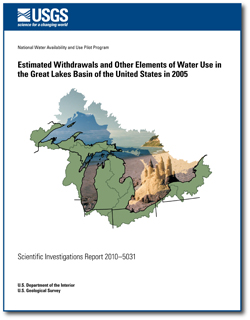Scientific Investigations Report 2010–5031

ABSTRACTEstimates of water withdrawals in the United States part of the Great Lakes Basin and 107 of its watersheds designated by the 8-digit hydrologic unit code (HUCs) indicate that about 30.3 billion gallons per day (Bgal/d) were withdrawn for practically all categories of use in 2005. Virtually all water withdrawn was freshwater. Surface-water withdrawals totaled 28.8 Bgal/d, or 95 percent of total withdrawals; about 24 Bgal/d was withdrawn from the Great Lakes or their connecting channels. Total withdrawals, and total surface-water withdrawals, decreased 7 percent from 1995 to 2005, generally following the withdrawal trends of industrial use and that of the largest use—thermoelectric power. Groundwater withdrawals increased 3 percent from 1995 to 2005 and 33 percent during 1985–2005. The substantial increase since 1985 results primarily from increases in irrigation and self-supplied domestic withdrawals. In 2005, withdrawals for public supply, domestic, and irrigation use accounted for 81 percent of groundwater withdrawals. About 21.9 Bgal/d, or 72 percent of total withdrawals for 2005, was used for thermoelectric power. Virtually all of this water was derived from surface water and used for once-through cooling at powerplants. As such, the reuse potential of this water in the basin is high, with the majority of the withdrawn water returned to its surface-water source. Public-supply withdrawals were 3.81 Bgal/d (13 percent), with withdrawals declining by about 13 percent from 1995 to 2005. In 2005, about 77 percent of the population in the Great Lakes Basin obtained drinking water from public suppliers, compared to about 78 percent in 1995 and 83 percent in 1985. Surface water consistently provided about 88 percent of the total withdrawals for public supply since 1985. Self-supplied industrial withdrawals in 2005 totaled 2.93 Bgal/d (10 percent), possibly as much as 30 percent less than in 1995. Surface water was the source for 95 percent of industrial withdrawals. Combined withdrawals for mining, irrigation, domestic, aquaculture, and livestock use (in order of decreasing rate) were 1.63 Bgal/d, or only 5 percent of total withdrawals; the withdrawals were distributed almost equally between surface-water and groundwater sources. Withdrawals for each of these uses, except livestock, increased almost continuously during 1985–2005. Withdrawals for mining increased 103 percent and for irrigation 94 percent during 1985–2005; livestock withdrawals decreased 25 percent from their peak in 1990. The number of irrigated acres increased 56 percent since 1985, totaling 750,000 acres in 2005. No use of reclaimed wastewater for industrial or irrigation applications was reported; however, sources of information regarding its use were sparse. Within the basin, the Lake Michigan watershed accounted for 15.0 Bgal/d, or 49 percent, of total water withdrawals for 2005; an estimated 12.3 Bgal/d was withdrawn directly from Lake Michigan. The State of Michigan accounted for 38 percent of total water withdrawals, representing the largest surface-water withdrawals (primarily for thermoelectric power use) and groundwater withdrawals (primarily for public supply and self-supplied domestic use). A disproportionately large percentage of surface-water withdrawals (6 percent, 1.80 Bgal/d) were in Illinois, given this state represents less than 1 percent of the land area of the basin. Ninety percent of the Illinois population served by the water withdrawn from Lake Michigan for public supply resides outside the basin. Within land-based HUCs, the Lower Maumee (04100009) of Ohio accounted for the largest total withdrawal and total surface-water withdrawal (about 0.75 Bgal/d). The St. Joseph (04050001) of Michigan and Indiana accounted for the largest total groundwater withdrawal (0.25 Bgal/d). |
First posted May 20, 2010 For additional information contact: Part or all of this report is presented in Portable Document Format (PDF); the latest version of Adobe Reader or similar software is required to view it. Download the latest version of Adobe Reader, free of charge. |
Mills, P.C., and Sharpe, J.B., 2010, Estimated withdrawals and other elements of water use in the Great Lakes Basin of the United States in 2005: U.S. Geological Survey Scientific Investigations Report 2010–5031, 95 p.
Acknowledgments
Abstract
Introduction
Withdrawals and Other Elements of Water Use
Trends in Water Withdrawals, 1985–2005
Consumptive Use
Uncertainty in Estimates
Summary
References Cited
Glossary
Appendix 1. Estimates of Withdrawals and Other Elements of Water Use by 8-Digit Hydrologic (Cataloging) Unit Codes (HUC) in the Great Lakes Basin, 2005